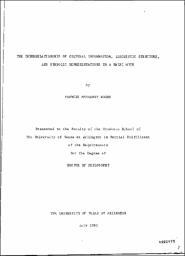
ATTENTION: The works hosted here are being migrated to a new repository that will consolidate resources, improve discoverability, and better show UTA's research impact on the global community. We will update authors as the migration progresses. Please see MavMatrix for more information.
Show simple item record
| dc.contributor.author | Woods, Frances Margaret | |
| dc.date.accessioned | 2020-10-09T21:09:35Z | |
| dc.date.available | 2020-10-09T21:09:35Z | |
| dc.date.issued | 1980-07 | |
| dc.identifier.uri | http://hdl.handle.net/10106/29506 | |
| dc.description.abstract | The mythology of the Halbi people reveals and reflects their cognitive orientation (and, in the process, validates their cultural values). The Halbis' myths are expressed through the linguistic form of narrative discourse but mere analysis of the form of the discourse provides only a fragmentary understanding of the content. As a result, linguistic analysis is only part of discourse analysis. Discourse analysis also calls for an analysis of the cultural setting and of the dynamic interplay between the culture and language in terms of the message (or meaning) of a given myth within a given culture. This study represents an attempt to reach a satisfactory understanding of a single myth by examining the cultural information, linguistic structure, and symbolic representations in one Halbi myth. The cultural information in this myth may be typical or atypical of the Halbis' culture. Culturally typical information may be made explicit or left implicit depending upon the narrator's intent. Culturally atypical information may represent the Halbis' perception of another culture or may be atypical of any culture. The interplay of these kinds of cultural information within the myth, while providing cohesion and prominence in the text, also serves to contrast participant with participant and contributes directly to the development of the plot (in both its narrative and didactic aspects). Chapters 1 through 3 describe these various kinds of cultural information. The myth is a narrative discourse and this study examines its linguistic structure in terms of both the high level constituent structures (discourse, episodes, embedded discourses, and so forth) and the non-hierarchical features (eventline, participant reference, and so forth). The narrative structure develops to a linguistically well-defined narrative peak that represents the climax of the entertainment aspect of the discourse. Chapters 4 and 5 describe the linguistic structure of the myth. The symbolic representations described in this study include the following considerations. Firstly, the role of both the myth's participants and props in the Halbi culture and the extension of that role to their roles in the myth results in a significant impact on the message by providing strong validation for it. Secondly, various rhetorical structures (such as oppositions, reflections, and mirror images), while providing cohesion and prominence to the text, also contribute to the development of the participants in their symbolic roles in the myth as the message is developed. Finally, consideration of the message itself reveals the development of a didactic plot that develops to a didactic peak. This didactic peak contrasts with the narrative peak. Chapters 6 through 8 describe the symbolic representations in the myth. | en_US |
| dc.language.iso | en_US | en_US |
| dc.publisher | University of Texas at Arlington | en_US |
| dc.subject | Language | en_US |
| dc.subject | Literature and linguistics | en_US |
| dc.title | THE INTERRELATIONSHIP OF CULTURAL INFORMATION, LINGUISTIC STRUCTURE, AND SYMBOLIC REPRESENTATIONS IN A HALBI MYTH | en_US |
| dc.type | Dissertation | en_US |
| thesis.degree.department | Linguistics | |
| thesis.degree.name | Doctor of Philosophy in Linguistics | |
Files in this item
- Name:
- The Interrelationship of Cultural ...
- Size:
- 14.92Mb
- Format:
- PDF
- Description:
- PDF
This item appears in the following Collection(s)
Show simple item record


